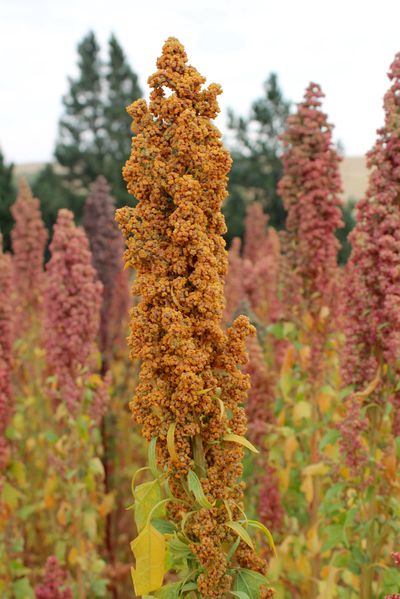Quinoa seed of change for Palouse farmers

PULLMAN – When Ian Clark needs to wash the quinoa seeds he grows on his farm just north of Albion, he first finds a pillowcase.
After putting the tiny seeds in the pillowcase and tying it off, he runs it through his clothes washer three times. Then he sets it on screens and blow dries it with fans.
“There’s a coating on the quinoa that is quite hard to get off,” said Clark, who planted 10 acres of quinoa in 2013. “It’s a big process because you can’t let it stay wet too long, otherwise it germinates.”
The Palouse has the potential to be a great region for growing the grain, according to Kevin Murphy, assistant professor in crop and soil sciences at Washington State University. Quinoa imports have risen from about 4 million pounds in 2007 to 73 million pounds in 2013, and international markets are struggling to keep up with the demand, according to WSU.
The highly nutritional crop looks and cooks much like rice, contains all the amino acids the body needs and is gluten-free, Murphy said. But as Clark and other farmers have learned, processing the grain can be tricky.
Murphy is hoping to launch a prototype processing facility for quinoa at WSU that would provide a place for quinoa to be washed before it is packaged and shipped.
“The bottleneck to production is taking it to a production facility,” Murphy said. “Quinoa requires a special facility. It’s not something farmers can do just in their shop.”
Murphy has been leading research on growing and testing quinoa varieties in Washington since 2010. He’s trying to discover the best environments around the state for the crop that’s traditionally found in South America. His research is funded by a $1.6 million grant from the National Institute of Food and Agriculture, and the funding is divided among four universities: WSU, Oregon State University, Utah State University and Brigham Young University.
Murphy said the Palouse has the potential to be a big quinoa-producing area because of its mild summer temperatures, rich soil, and the fact that growers there are already accustomed to small-seed crops, so they would not need to buy new equipment.
Quinoa is coated in a soapy material called saponin that needs to be washed off before the quinoa can be eaten, said Lynne Carpenter-Boggs, associate professor of crop and soil science at WSU. Carpenter-Boggs is working with a graduate student on the quinoa project.
“Quinoa does require some extra processing because the quinoa seed is so little that it is relatively hard to separate out all the other plant bits,” Carpenter-Boggs said.
The effort is worth it, she added.
“It’s an excellent source of very balanced protein. It has many different uses,” she said. “You can use it in the way we usually use rice, or you can use it in breads, flours or desserts. It’s a very different crop than we currently grow in this area, so it could be an excellent rotation crop.”
For farmers like Clark, who also grows wheat and chickpeas, a processing center would be critical to his harvest.
“The market is there and we know we can grow it,” Clark said.
Clark also said there is interest in quinoa from local farmers.
“People are paying attention to new crops, and a lot of farmers are interested in diversifying their crops,” he said.
A processing facility is not certain yet, and Clark said there is a long road before one would open. But the benefits of such a facility would be felt locally and in South America, Carpenter-Boggs said.
“It would very definitely be a positive economically here. There would be new processing and packing facilities,” she said. “As far as what would happen in Central America … it certainly looks like the demand is growing so fast that even now those production areas can’t keep up with the demand. Our expectation would be that we would be meeting the unfilled demand and the future growth of the whole market so that South America would still be a production area.”